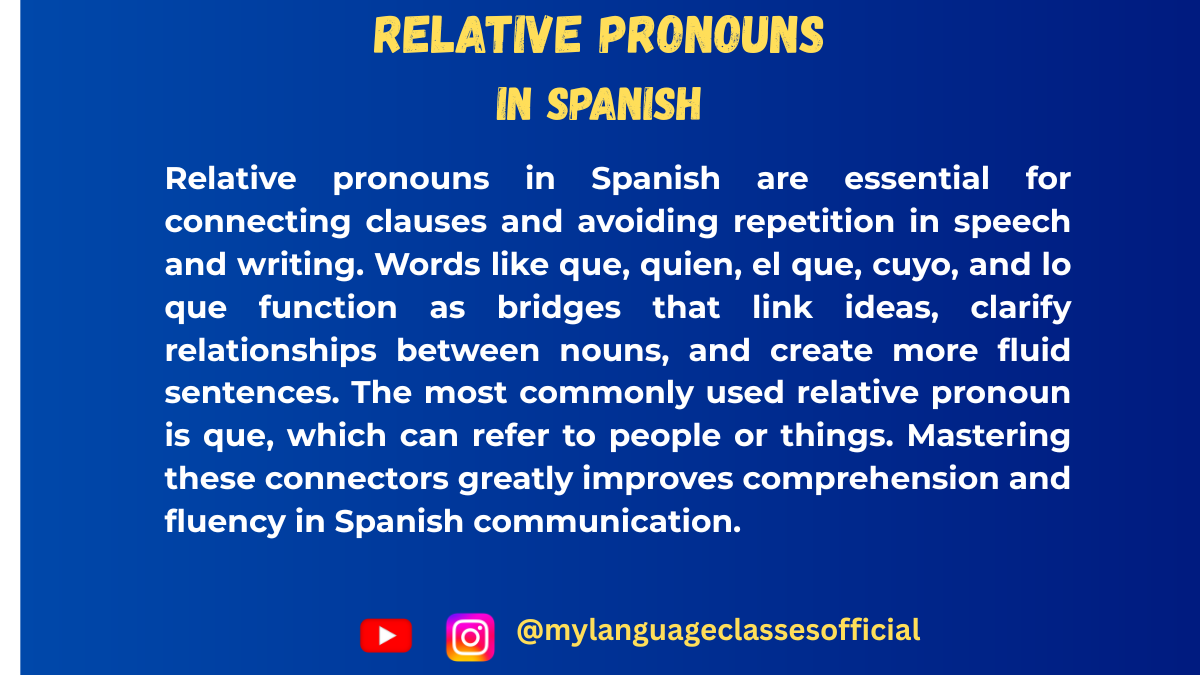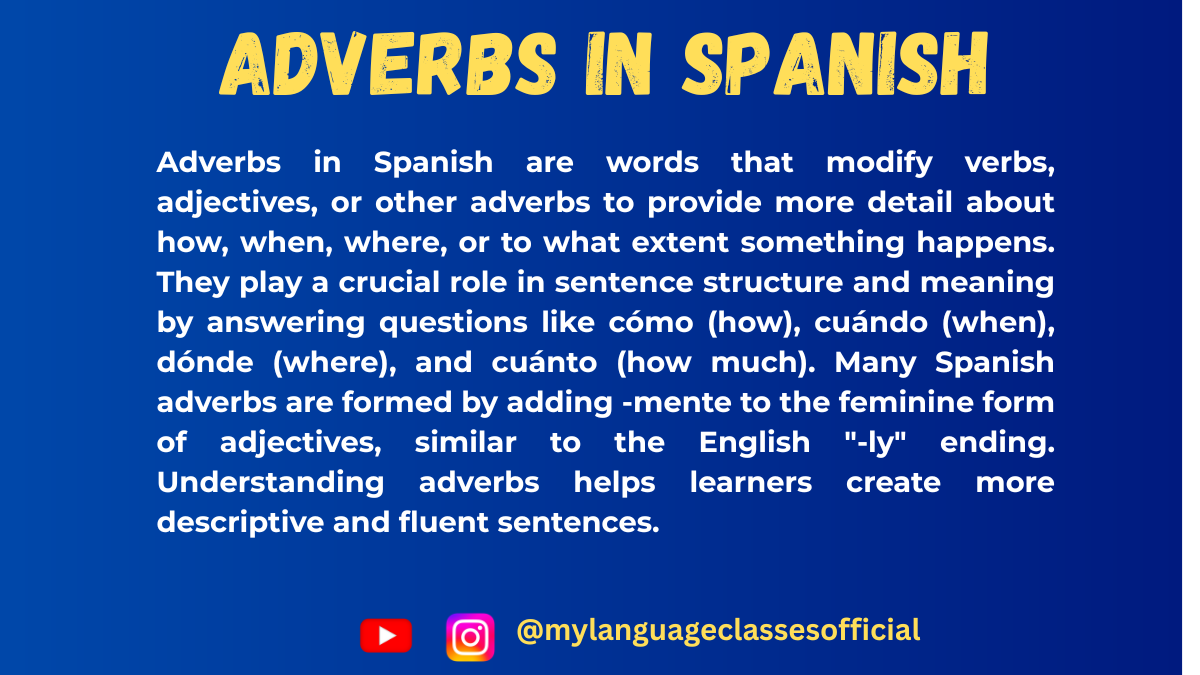Your cart is currently empty!
Tag: improve Spanish fluency
-

Relative Pronouns in Spanish: Que, Quien, Donde, and Others
When learning Spanish, relative pronouns are essential for connecting sentences smoothly and making speech more fluid. These pronouns allow us to refer to people, places, or things without unnecessary repetition. In this blog post, we will explore the different relative pronouns in Spanish, their meanings, and how to use them correctly.
List of Relative Pronouns in Spanish
Relative pronouns in Spanish are used to introduce subordinate clauses and refer to a previously mentioned noun (antecedent). Below is a list of the most common relative pronouns, their meanings, and example sentences:
Relative Pronoun Meaning Example Sentence 1 Example Sentence 2 Que That, which, who La casa que compré es muy grande. La película que vimos fue interesante. Quien / Quienes Who, whom Mi amiga, quien vive en Madrid, me visitó ayer. Los estudiantes, quienes aprobaron, celebraron. Cuyo / Cuya / Cuyos / Cuyas Whose El hombre cuyo coche es rojo está aquí. La chica cuya madre es doctora es mi amiga. Donde Where La ciudad donde nací es hermosa. Este es el restaurante donde cenamos anoche. El que / La que / Los que / Las que The one(s) who/that El libro, el que compraste, es interesante. Las chicas, las que llegaron tarde, son mis amigas. El cual / La cual / Los cuales / Las cuales The one(s) who/that (formal) La casa en la cual crecí está en ruinas. Los estudiantes, los cuales fueron premiados, estaban felices. Lo que What, which No entiendo lo que dijiste. Lo que más me gusta es viajar. Lo cual Which (referring to a whole idea) Perdimos el tren, lo cual fue un problema. Llegó tarde, lo cual nos molestó mucho. Cuanto / Cuanta / Cuantos / Cuantas As much/many as Toma cuanto quieras. Cuantas veces lo intentó, falló. More Example Sentences
- La mujer que trabaja en la tienda es muy amable.
- Mi amigo, quien es muy inteligente, siempre me ayuda.
- El perro cuyo dueño es mi vecino es muy juguetón.
- No entiendo lo que está pasando.
- El país donde nací es hermoso.
- Los estudiantes, los cuales estudian mucho, sacaron buenas notas.
- La casa en la que crecí tiene muchos recuerdos.
- No sé lo que quieres decir.
- Las flores que compraste son muy bonitas.
- La ciudad donde vivo tiene muchas atracciones turísticas.
Things to Keep in Mind
- Agreement in Gender and Number:
- “Cuyo” agrees in gender and number with the noun it modifies: El hombre cuyos hijos estudian aquí…
- “El que, la que, los que, las que” also change according to the noun they refer to.
- Use of Articles:
- “El cual, la cual, los cuales, las cuales” often appear with a preposition and are more formal.
- “Lo que” and “lo cual” refer to entire ideas or situations.
- Que vs. Quien:
- “Que” is used for both people and objects.
- “Quien” is used mainly for people and must match singular or plural (quien/quienes).
- Where to Use Relative Pronouns:
- “Donde” is for places.
- “Lo que” and “lo cual” refer to abstract concepts.
- “Cuyo” means “whose” and agrees with the possessed noun.
Fill in the Blanks
- La chica _______ vive al lado es muy simpática.
- El perro _______ dueño es mi vecino ladra mucho.
- No entiendo _______ dices.
- La ciudad _______ naciste es hermosa.
- Mi amigo, _______ es doctor, trabaja en el hospital.
- Las flores, _______ compraste ayer, están muy bonitas.
- Juan, _______ hermano es mi compañero, me ayudó con la tarea.
- La razón por _______ llegamos tarde fue el tráfico.
- No sabía _______ querías decir.
- El edificio _______ ventanas son grandes es nuevo.
Answers
- que
- cuyo
- lo que
- donde
- quien
- las que
- cuyo
- la cual
- lo que
- cuyas
Conclusion
Mastering relative pronouns in Spanish is essential for improving fluency and making speech more natural. Understanding the gender, number agreement, and context in which each pronoun is used will help you construct sentences more accurately. Keep practicing with different sentence structures, and soon, using these pronouns will become second nature.
If you enjoyed this lesson, be sure to check out more posts like this on my blog at My Language Classes. Don’t forget to subscribe my YouTube channel and follow me on Instagram for the latest language learning tips and lessons. Leave a comment below to share your thoughts, or ask any questions you have.
Happy learning! 😊
-

Exploring Spanish Adverbs
Adverbs are essential in Spanish, providing important details about actions—when, where, and how often they happen. Mastering adverbs will help you express yourself more clearly and accurately in everyday conversations. In this blog post, we’ll break down three important types of adverbs: adverbs of frequency, adverbs of time, and adverbs of place. Each type has its own role in enriching your sentences.
1. Adverbs of Frequency: How Often?
Adverbs of frequency tell us how often an action takes place. They are essential for describing habits, routines, and general tendencies in our daily lives. Common adverbs of frequency in Spanish include words like siempre (always) and nunca (never), which are often used to express regularity or lack thereof.
For example:
- Siempre (Always): Yo siempre tomo café por la mañana.
(I always drink coffee in the morning.) - Nunca (Never): Nunca llego tarde al trabajo.
(I never arrive late to work.)
Here’s a table summarizing common adverbs of frequency, their English meanings, and example sentences:
Adverbs of Frequency
Adverb (Spanish) English Meaning Example Sentence (Spanish) Translation (English) Siempre Always Yo siempre tomo café por la mañana. I always drink coffee in the morning. A menudo Often Ellos visitan a sus abuelos a menudo. They often visit their grandparents. Frecuentemente Frequently Los niños frecuentemente juegan en el parque. The children frequently play in the park. A veces Sometimes A veces leo libros en la biblioteca. Sometimes I read books in the library. Rara vez Rarely Ella rara vez come comida rápida. She rarely eats fast food. Nunca Never Nunca llego tarde al trabajo. I never arrive late to work. Tip: In Spanish, adverbs of frequency like siempre and nunca typically come before the verb, while others like a veces and frecuentemente can vary in position for emphasis.
2. Adverbs of Time: When?
Adverbs of time tell us when an action happens. They help us frame the timeline of a conversation, allowing us to specify moments in time—whether something happens right now, in the past, or in the future.
For example:
- Ahora (Now): Estoy estudiando ahora. (I am studying now.)
- Mañana (Tomorrow): Mañana tengo una reunión importante. (Tomorrow I have an important meeting.)
Here’s a table with some common adverbs of time and examples:
Adverbs of Time
Adverb (Spanish) English Meaning Example Sentence (Spanish) Translation (English) Ahora Now Estoy estudiando ahora. I am studying now. Hoy Today Hoy vamos al cine. Today we are going to the cinema. Mañana Tomorrow Mañana tengo una reunión importante. Tomorrow I have an important meeting. Ayer Yesterday Ayer cociné una paella deliciosa. Yesterday I cooked a delicious paella. Tarde Late Llego tarde a la clase de español. I am late for the Spanish class. Temprano Early Siempre llegamos temprano al aeropuerto. We always arrive early at the airport. Tip: When using adverbs of time, be sure to place them where they make the most sense contextually—before or after the verb depending on what you want to emphasize.
3. Adverbs of Place: Where?
Adverbs of place answer the question “Where?” These adverbs describe the location of an action. They are especially helpful in giving directions or providing specific details about where something happens. Common adverbs of place include aquí (here), allí (there), cerca (close), and lejos (far).
For example:
- Aquí (Here): Ven aquí, por favor. (Come here, please.)
- Lejos (Far): Su oficina está lejos de la estación de tren. (Their office is far from the train station.)
Here’s a table summarizing common adverbs of place:
Adverbs of Place
Adverb (Spanish) English Meaning Example Sentence (Spanish) Translation (English) Aquí Here Ven aquí, por favor. Come here, please. Allí There Dejé mis llaves allí. I left my keys there. Cerca Close/Nearby Hay un supermercado cerca de mi casa. There’s a supermarket near my house. Lejos Far Su oficina está lejos de la estación de tren. Their office is far from the train station. Dentro Inside El gato está dentro de la caja. The cat is inside the box. Fuera Outside Los niños juegan fuera. The children play outside. Tip: Adverbs of place often go after the verb, but they can sometimes appear at the beginning of the sentence for emphasis.
Final Thoughts
Adverbs are powerful tools in Spanish that help add context to your sentences. By using adverbs of frequency, adverbs of time, and adverbs of place, you can make your speech or writing much more expressive. Practice using them in different contexts, and soon they will become a natural part of your Spanish communication.
¡Buena suerte en tu aprendizaje! (Good luck with your learning!)
If you enjoyed this lesson, be sure to check out more posts like this on my blog at My Language Classes. Don’t forget to subscribe my YouTube channel and follow me on Instagram for the latest language learning tips and lessons. Leave a comment below to share your thoughts, or ask any questions you have.
Happy learning! 😊
- Siempre (Always): Yo siempre tomo café por la mañana.
